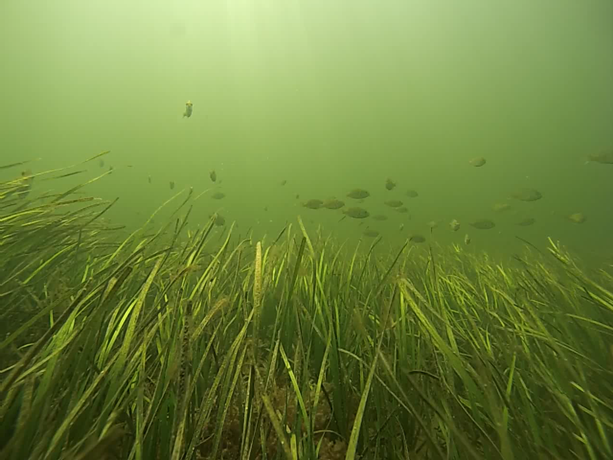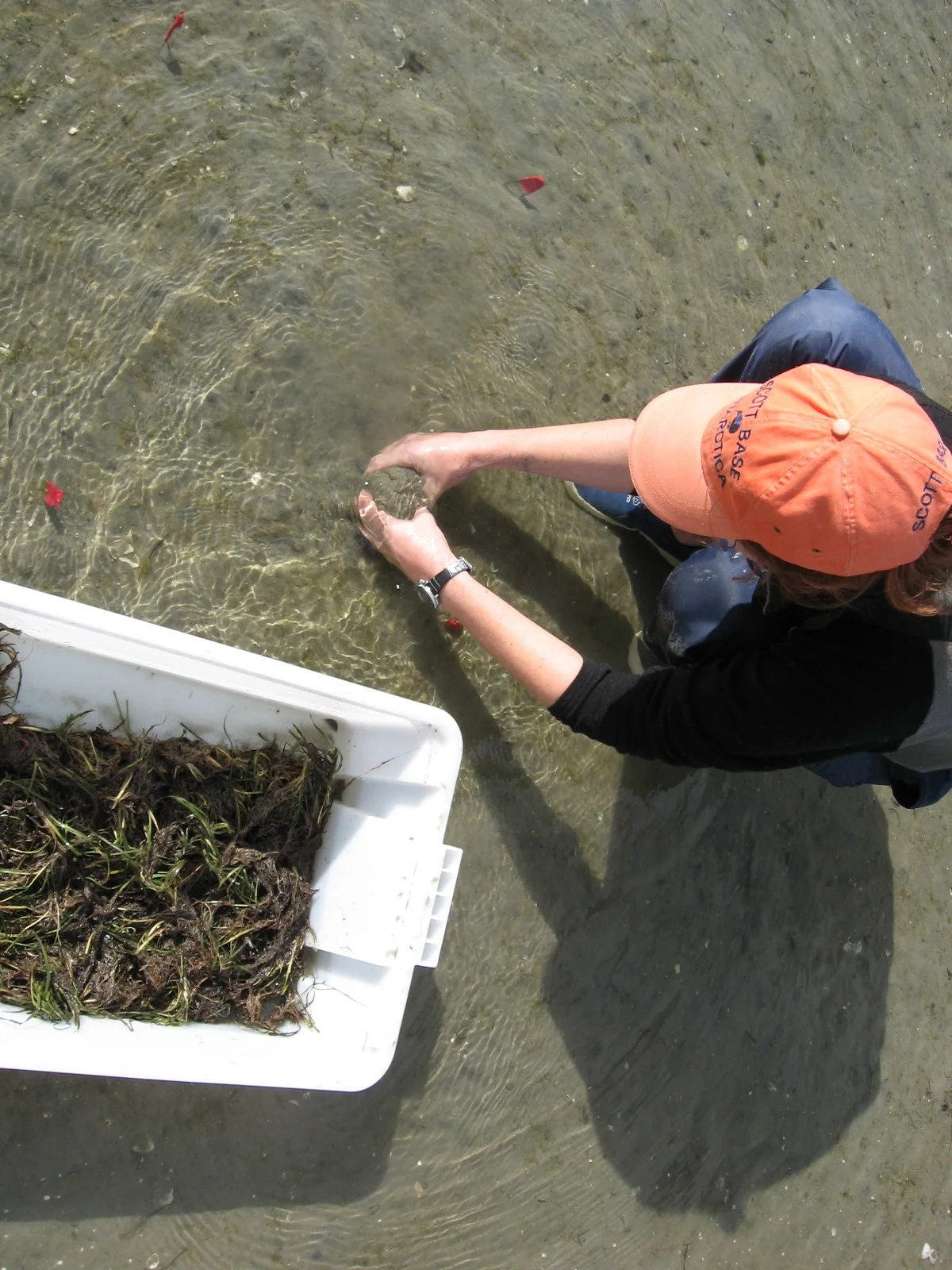SEAGRASS TRANSPLANTS CONTRIBUTE TO REGENERATING SEAGRASS IN WHANGAREI HARBOUR, NEW ZEALAND
FLEUR MATHESON
NATIONAL INSTITUTE OF WATER AND ATMOSPHERIC RESEARCH, NEW ZEALAND
Photo 1 Subtidal meadows of Zostera muelleri in Northern New Zealand are important nursery habitat for fish stocks
(Photo: Mark Morrison).
Photo 2 Transplanting “sprigs” of Zostera muelleri into 0.25m2 experimental plots on the Takahiwai sandflats, Whangarei Harbour, in April 2008
(Photo: Jacquie Reed).
ZOSTERA RESTORATION
Prior to the 1970s Whangarei Harbour in Northern New Zealand had extensive areas of intertidal and subtidal seagrass totally c. 1400 hectaresor or about 10% of the harbour (Reed et al. 2004). Amongst the vital ecosystem services provided by this primary producer, the subtidal meadows are nurseries for fish stocks with high commercial, recreational and cultural value, including Australasian snapper (Pagrus auratus) and trevally (Pseudocaranx georgianus) (Photo 1). The seagrass meadows here and elsewhere in NZ are composed of one species, Zostera muelleri (syn. Z. capricorni, Z. novazelandica).
In the late 1960s, the seagrass meadows in Whangarei Harbour underwent a dramatic decline due to human activities so that, several decades later, only small remnants remained (Reed et al. 2004). However, changes to industrial discharge and harbour dredging practices during this time enabled an apparent improvement in harbour water quality, whereby the remnants appeared to begin a slow expansion.
In April 2008, Northport, local Māori, the Northland Regional Council and NIWA, through the Whangarei Harbour Health Improvement Fund, initiated a trial to transplant seagrass from the largest remnant (c. 5 ha) at One Tree Point to the Takahiwai sand flats, an area with past extensive seagrass meadows. The 2 year trial was quite successful. Three transplanting methods were tested and two of these (using “sod” and “sprig” units) worked very well (Photo 2). The unsuccessful method was planting sprigs amongst mats of artificial seagrass, which did not enhance conditions for growth as expected. The donor site recovered rapidly (Photo 3). At the conclusion of the trial not only had all of the sod and sprig transplants survived and flourished but an extensive area of seagrass, many tens of hectares in extent, including the subtidal zone, had regenerated across the Takahiwai sand flats (Photo 4). Local Māori in particular were pleased with this outcome and reported improved fish catches following the return of seagrass to this area (G. Pirihi, Takahiwai, pers. comm).
Photo 3 Local volunteers monitoring seagrass recovery at the One Tree Point donor site, Whangarei Harbour, in October 2009
(Photo: Fleur Matheson).
Photo 4 The regenerated seagrass meadows on the Takahiwai sandflats, Whangarei Harbour, in April 2013 (Photo: Crispin Middleton).
Photo 5 Zostera muelleri transplants at McDonald Bank, Whangarei Harbour, in July 2016, which have spread slowly and steadily since planting four years earlier (Photo: Crispin Middleton).
Another two years on, in July 2012, a second trial was initiated to try and reestablish seagrass at another important former site, McDonald Bank, one of several large offshore sand banks in the harbour, using the newly regenerated Takahiwai meadows as a donor site. Four years on, this trial has also been quite successful. All of the four planting configurations tested, from planting a cluster of five small seagrass cores (10 cm diameter) to larger plots of 0.5 m2, have been comparably effective. Virtually all of the 24 transplant units have gradually spread to occupy c. 25 to 35 m2 each, and a total area of c. 750 m2 (Photo 5). We anticipate that this slow and steady expansion will continue.
Within the harbour as a whole, seagrass has now re-established at a number of its former sites of occupation.
We estimate it now occupies c. 40% of its former range.
These trials have demonstrated that it is possible to successfully transplant this species of seagrass to enhance the natural “restoration” process, once the conditions responsible for its past demise have been ameliorated to a sufficient extent.
References
Reed J, Schwarz A, Gosai A, Morrison M (2004) Feasibility study to investigate the replenishment/reinstatement of seagrass beds in Whangarei Harbour – Phase 1. NIWA Report for Northland Regional Council, 22p.
Morrison MA, Lowe ML, Grant C, Smith PJ, Carbines G, Reed J, Bury SJ, Brown J (2014) Seagrass meadows as biodiversity and productivity hotspots. New Zealand Aquatic Environment and Biodiversity Report No 137. Ministry for Primary Industries, Wellington, 147p.





